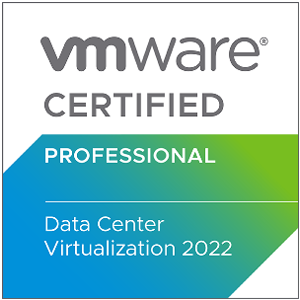
VMware vSphere Fast Track 7.0
Tällä VMware vSphere Fast Track 7.0 -kurssilla opit paitsi vSphere 7.0 ympäristön pystytyksen ja määrittelyn myös isommissa ympäristöissä tarvittavien ominaisuuksien käytön. Lähtien asennuksesta ja määrittelystä aina ylläpitoon ja seurantaan asti sekä VMware ESXi™ 7:n ja VMware vCenter Server® 7:n osalta.
Huom. Tällä kurssilla käydään 5 kalenteripäivässä 7 päivän asiat. Kurssi sisältää sekä VMware vSphere: Install, Configure, Manage 7.0 -kurssin sisällön, että myös osan Optimize & Scale 7.0 -kurssin asioista. Siksi tässä koulutus on tavallista pidemmät kurssipäivät ja etenemisvauhti nopeampi.
Kurssin vetäjänä toimii pitkäaikainen VMware vSphere -ammattilainen, VCI, VCIX, VCAP Pertti Pellonpoika. Opetus on suomeksi.
Tämän kurssin sisältöä ja VMware materiaalia täydennetään ajan puitteissa kouluttajan omalla materiaalilla.


Kurssilla saamasi taidot
VMware vSphere: Fast Track 7.0 -kurssin jälkeen osaat pystyttää ja määrittää VMware vSphere -ympäristön ja hyödyntää sitä täysipainoisesti sekä myös sen Enterprise eli skaalautuvuus ominaisuuksia.
Kurssin jälkeen sinulla on erityisesti seuraavat taidot:
• Describe the software-defined data center (SDDC)
• Explain the vSphere components and their function in the infrastructure
• Describe the benefits and capabilities of VMware Skyline
• Install and configure VMware ESXi™ hosts
• Deploy and configure VMware vCenter® Server Appliance™
• Use VMware vSphere® Client™ to manage the vCenter Server inventory and the vCenter Server configuration
• Manage, monitor, back up, and protect vCenter Server Appliance
• Create virtual networks with vSphere standard switches
• Describe the storage technologies supported by vSphere
• Configure virtual storage using iSCSI and NFS storage
• Create and manage VMware vSphere® VMFS datastores
• Use the vSphere Client to create virtual machines, templates, clones, and snapshots
• Create a content library and deploy virtual machines from templates in the library
• Manage virtual machine resource use and manage resource pools
• Migrate virtual machines with VMware vSphere® vMotion® and VMware vSphere® Storage vMotion®
• Create and manage a vSphere cluster that is enabled with VMware vSphere® High Availability and VMware vSphere® Distributed Resource Scheduler™
• Create virtual networks with VMware vSphere® Distributed Switch™ and enable distributed switch features
• Discuss solutions for managing the vSphere life cycle
• Use VMware vSphere® Lifecycle Manager™ to perform upgrades to ESXi hosts and virtual machines
• Use host profiles to manage ESXi configuration compliance
• Describe how vSphere storage APIs help storage systems integrate with vSphere
• Configure and use virtual machine storage policies
Kenelle ja esivaatimukset
Tämä kurssi sopii kaikille, joiden omissa tai joiden asiakkaiden yrityksissä käytetään VMware vSphere tuotteita sekä mahdollisesti myös vSphere Enterprise Plus version kehittyneimpiä ominaisuuksia. Kurssi sopii siis kaikille VMware-virtualisointiratkaisujen kanssa tekemisissä oleville tai niille, joiden on hyvä tietää vMware vSphere -ympäristön mahdollisuudet ja rajoitukset. Kurssi sopii hyvin myös VMware VCP-DCV sertifiointiin tähtääville.
Tämä kurssi lähtee liikkeille perusasioista, joten VMware vSpheren osaamista tai kokemusta ei edellytetä. Jos olet joitain osa-alueita käyttänyt tai muutoin oppinut saat laajemman ja perusteellisen opin tuotteesta.
Koulutuksen sisältö
1 Course Introduction
• Introductions and course logistics
• Course objectives
2 Introduction to vSphere and the Software-Defined Data Center
• Explain basic virtualization concepts
• Describe how vSphere fits into the software-defined data center and the cloud infrastructure
• Explain how vSphere interacts with CPUs, memory, networks, and storage
• Recognize the user interfaces for accessing the vCenter Server system and ESXi hosts
• Describe the ESXi host architecture
• Navigate the Direct Console User Interface (DCUI) to configure an ESXi host
• Recognize ESXi host user account best practices
• Install an ESXi host
• Use VMware Host Client™ to configure ESXi host settings
• Describe how to proactively manage your vSphere environment using VMware Skyline
3 Virtual Machines
• Create and provision a virtual machine
• Explain the importance of VMware Tools™
• Install VMware Tools
• Identify the files that make up a VM
• Recognize the components of a VM
• Recognize virtual devices supported by a VM
• Describe the benefits and use cases for containers
• Identify the parts of a container system
4 vCenter Server
• Describe the vCenter Server architecture
• Discuss how ESXi hosts communicate with vCenter Server
• Deploy and configure vCenter Server Appliance
• Use the vSphere Client to manage the vCenter Server inventory
• Add data center, organizational objects, and hosts to vCenter Server
• Use roles and permissions to enable users to access objects in the vCenter Server inventory
• Back up vCenter Server Appliance
• Monitor vCenter Server tasks, events, and appliance health
• Use vCenter Server High Availability to protect a vCenter Server Appliance
5 Configuring and Managing Virtual Networks
• Create and manage standard switches
• Describe the virtual switch connection types
• Configure virtual switch security, traffic-shaping and load-balancing policies
• Compare vSphere distributed switches and standard switches
6 Configuring and Managing Virtual Storage
• Identify storage protocols and storage device types
• Discuss ESXi hosts using iSCSI, NFS, and Fibre Channel storage
• Create and manage VMFS and NFS datastores
• Explain how multipathing works with iSCSI, NFS, and Fibre Channel storage
• Recognize the components of a VMware vSAN™ configuration
7 Virtual Machine Management
• Use templates and cloning to deploy new virtual machines
• Modify and manage virtual machines
• Create a content library and deploy virtual machines from templates in the library
• Use customization specification files to customize a new virtual machine
• Perform vSphere vMotion and vSphere Storage vMotion migrations
• Describe Enhanced vMotion Compatibility
• Create and manage virtual machine snapshots
• Examine the features and functions of VMware vSphere® Replication™
• Describe the benefits of vSphere Storage APIs – Data Protection
8 Resource Management and Monitoring
• Discuss CPU and memory concepts in a virtualized environment
• Describe what overcommitment of a resource means
• Describe methods for optimizing CPU and memory usage
• Use various tools to monitor resource use
• Create and use alarms to report certain conditions or events
9 vSphere Clusters
• Describe the functions of a vSphere DRS cluster
• Create a vSphere DRS cluster
• Monitor a vSphere cluster configuration
• Describe options for making a vSphere environment highly available
• Explain the vSphere HA architecture
• Configure and manage a vSphere HA cluster
• Examine the features and functions of VMware vSphere® Fault Tolerance
• Describe the function of the vSphere® Cluster Service
10 Network Scalability
• Configure and manage vSphere distributed switches
• Describe how VMware vSphere® Network I/O Control enhances performance
• Explain distributed switch features such as port mirroring and NetFlow
11 vSphere Lifecycle Management
• Recognize the importance of vCenter Server Update Planner
• Describe how VMware vSphere® Lifecycle Manager™ works
• Describe how to update ESXi hosts using baselines
• Validate ESXi host compliance using a cluster image
• Describe how to upgrade VMware Tools and VM hardware
• Describe VMware vSphere® Lifecycle Manager™ and VMware vSAN™ integration
12 Host and Management Scalability
• Use host profiles to manage ESXi configuration compliance
• Create and manage resource pools in a cluster
• Describe how scalable shares work
13 Storage Scalability
• Explain why VMware vSphere® VMFS is a high-performance, scalable file system
• Explain VMware vSphere® Storage APIs – Array Integration, VMware vSphere® API for Storage
Awareness™, and vSphere APIs for I/O Filtering
• Configure and assign virtual machine storage policies
• Create VMware vSAN™ storage policies
• Recognize components of the vSphere Virtual Volumes architecture
• Configure VMware vSphere® Storage DRS™ and VMware vSphere® Storage I/O Control
Testi ja sertifiointi
Tämä kurssi valmentaa Professional VMware vSphere 7.x (2V0-21.20) -testiin, jolla saavutat Data Center Virtualization 2022 (VCP-DCV 2022) -sertifioinnin. Testin läpäiseminen edellyttää kuitenkin kurssin lisäksi myös omaehtoista tutustumista VMwaren dokumentaatioon ja työskentelemistä tuotteen parissa.
Kysy lisää VMware koulutuksista tai konsultoinnista
Laita sähköpostia suoraan minulle pertti.pellonpoika@itop.fi tai täytä lomake alla.
Jos haluat että soitan takaisin laita viestiin myös mikä olisi sopiva ajankohta soitolle.
Tai voit myös varata heti ajan Online tapaamiselle.